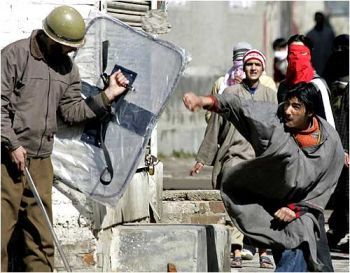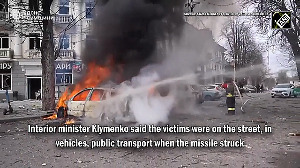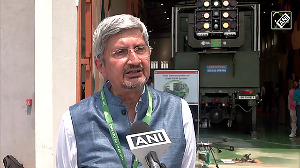 Lifting the AFSPA can certainly be attempted but the provisions of the AFSPA, as an emergency law that empowers the army -- the nation’s instrument of last resort -- must continue to remain on the statute books given the increasingly violent and uncertain times that the subcontinent is likely to face in coming years, says Nitin A Gokhale.
Lifting the AFSPA can certainly be attempted but the provisions of the AFSPA, as an emergency law that empowers the army -- the nation’s instrument of last resort -- must continue to remain on the statute books given the increasingly violent and uncertain times that the subcontinent is likely to face in coming years, says Nitin A Gokhale.
Two developments in Kashmir during the past fortnight have brought back the focus on the Indian Army and the much-misunderstood Armed Forces (Special Powers) Act, 1958.
First, the killing of two teenagers in Badgam by troops of the Rashtriya Rifles and the subsequent admission by the Northern Army Commander Lt Gen D S Hooda that "we made a mistake," has given a handle to the critics of the AFSPA and fuelled once again the oft-repeated demand to repeal the law.
However, the verdict in the high-profile Machil fake encounter case of 2010 that sentenced five army men to life under the Army Act, 1950 (the punishment will have to be confirmed by the Northern Army Commander) within days of the Badgam incident has silenced -- even if momentarily -- critics of the army’s justice system.
But going beyond the immediate, a closer look is needed at the army’s deployment, the application of the AFSPA and the circumstances under which it has come to acquire such negative connotations. Discussion on the law, however, gets clouded by emotions, distrust and even lack of understanding about the circumstances under which it is applied.
When the AFSPA was made applicable in the state of J&K in 1990, India was fighting a well-funded proxy war fuelled by an implacable adversary. In the past 25 years, the country’s collective efforts have brought down all known parameters of violence down to manageable levels with the help of the Indian Army.
For a majority of the last quarter century, the army was the only functioning government agency in most parts of Kashmir. It ran schools, conducted vocational training programmes, built roads, set up micro-hydel plants and provided medical relief in remote areas. The army -- Rashtriya Rifles, to be precise -- was like the one-stop service centre for the local population. But it’s certainly time for the army to ‘step back’ a little in J&K and allow the civil administration to start playing its part in providing good governance.
That said, the army has sound reasons to resist the withdrawal of AFSPA. For instance, it says lifting of AFSPA from urban areas/large towns in J&K will result in terrorists seeking shelter in such areas and rebuilding their bases, as has been witnessed in Manipur’s capital Imphal post-2004.
While there may be a comparative decline in terrorist violence, there is no change in the Pakistani ideology and will to support proxy war in J&K. The infrastructure to support such a proxy is all intact and being regularly upgraded. Between 35 and 42 training camps are active in Pakistan-occupied Kashmir. Moreover, counter-terrorist operations by the army are not restricted to the Line of Control but cover the entire state.
Administrative support including convoys carrying army personnel and stores moving to the LoC pass through urban areas in the hinterland and are vulnerable to terrorist attacks. Hence AFSPA cannot be applied in pockets of J&K along the LoC while withdrawing the act from the remaining areas, as is being advocated by Chief Minister Omar Abdullah or even former Home Minister P Chidambaram.
Critics have often chafed at the provisions under Sections 3, 4, 6 and 7 of the AFSPA for being ‘draconian.’ What exactly are these provisions?
Section 3: It lays down the authority which has power to declare areas as ‘disturbed’. These authorities are the central and the state governments. So the army does not declare the area as disturbed.
Section 4: It gives the army powers to search premises and make arrests without warrants, to use force even to the extent of causing death, destroy arms/ammunition dumps, fortifications/shelters/hideouts and to stop, search and seize any vehicle.
Section 6: It stipulates that arrested persons and seized property are to be made over to the police with least possible delay.
Section 7: It offers protection of persons acting in good faith in their official capacity. Prosecution is permitted only after sanction by the central government.
These provisions came up for scrutiny before a constitution bench of the Supreme Court in a case titled ‘Naga People’s Movement of Human Rights Vs UOI’. The five-judge bench elaborately dealt with the challenge to the legality of deployment of the armed forces in aid to civil power. The court had then unambiguously ruled that AFSPA cannot be regarded as a colourable legislation or a fraud on the Constitution.
The apex court said that the conferring of powers vide Section 4 of AFSPA could not be held arbitrary or violative of Article 14, 19 or 21 of the Constitution. In fact, having considered the role and circumstances under which the armed forces have to operate, the Supreme Court extended the scope of powers vested vide 4 and 6 of AFSPA so as to include by implication, the power to interrogate the person arrested.
It also allowed the armed forces to retain the weapons seized during the operations in their own custody rather than to hand them over to police authorities.
The mere fact that the provisions of AFSPA have to be invoked in a particular area ex facie establishes that handling the law and order situation had gone beyond the control of the state government. The army personnel operating in those circumstances need to enjoy at least similar powers as the police force if not wider ones. So, just as Section 45 of the CrPC disallows arrest of public servants and just as Section 197 provides impunity against prosecution, Section 7 of the AFSPA gives similar protection to the army personnel. Nothing more, nothing less.
And yet, most opponents of the AFSPA have chosen to either downplay or completely ignore this similarity. In the case of J&K, the army needs legal protection all the more since applicability of CrPC is disallowed in the state that operates under a different set of laws called the Ranbir Penal Code.
So what is the way forward?
The revocation of AFSPA from any area needs a concerted view of all organs of the state and Centre. A suggested way is to convert these areas into police administered areas/police districts as was done for Srinagar initially without revoking AFSPA. Subsequently, as the situation improves, while evolving the revocation, an exit strategy needs to be worked out for gradual withdrawal of armed forces from the specified area leading to a smooth transition.
Lifting the AFSPA can certainly be attempted but the provisions of the AFSPA, as an emergency law that empowers the army -- the nation’s instrument of last resort -- must continue to remain on the statute books given the increasingly violent and uncertain times that the subcontinent is likely to face in coming years.
When needed, it must be applied in small doses. Every country has to balance the need for a stringent law with the basic principles of ensuring human dignity and human rights. Therein lies the challenge for India’s leadership.
Nitin A Gokhale is security & strategic affairs editor with NDTV.














 © 2025
© 2025